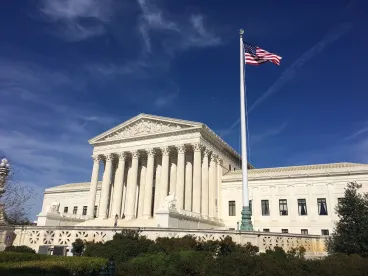On July 9, 2020, the U.S. Supreme Court held in McGirt v. Oklahoma, No. 18-9526, that the Creek Nation’s reservation in northeastern Oklahoma has never been disestablished. The decision resolves not only McGirt, but its predecessor Carpenter v. Murphy (now Sharp v. Murphy), which the Supreme Court was supposed to decide last term. Many believe the Supreme Court granted certiorari in McGirt to resolve a 4-4 tie in Murphy, which occurred because Justice Gorsuch was conflicted out of the case. Justice Gorsuch’s opinion for the five-member majority in McGirt is a significant victory for tribal sovereignty in Indian Country.
Factual Background
As recounted in our July 9 summary of the McGirt decision, “‘in a series of treaties’ in the 1800s, the Creek Nation agreed to relocate to what is now Oklahoma – and the United States ‘solemnly guarantied’ the Tribe ownership of its new lands, and agreed that the Tribe ‘would hold legal title to its lands’ in fee simple. The Creek relocated to Oklahoma as part of what is known as the Trail of Tears. Since that time, Congress has ‘broken more than a few of its promises to the Tribe.’ The Creek Nation’s original lands are now part of Oklahoma and heavily settled by non-members of the Tribe, including most of the city of Tulsa.
“James McGirt, an enrolled member of the Seminole Nation of Oklahoma, was convicted in Oklahoma state court of serious sexual offenses, based on conduct within the boundaries of the historic Creek lands. The federal Major Crimes Act makes certain crimes in ‘Indian country,’ [including felony sexual assault,] subject to ‘the exclusive jurisdiction of the United States.’ Therefore, McGirt argued in post-conviction proceedings that his state-court conviction was invalid because the Creek reservation was never disestablished,” meaning that his crimes were committed in Indian Country and subject to exclusive federal jurisdiction. The Oklahoma courts disagreed and upheld his conviction.
The U.S. Supreme Court’s Reasoning
The Supreme Court reversed by a 5-4 vote, adhering to the rule that “only Congress can divest a reservation of its land and diminish its boundaries,” and that it can do so only by clearly expressed intent, a rule it first applied in Solem v. Bartlett, 465 U.S. 463 (1984), and more recently reiterated in Nebraska v. Parker, 577 U.S. 481 (2016). The Court stated that “courts have no proper role in the adjustment of reservation boundaries.” Thus, “no matter how many other promises to a tribe the federal government has already broken[, i]f Congress wishes to break the promise of a reservation, it must say so.”
The Court started with an unequivocal ruling that Congress created and redefined a reservation for the Creek Nation in treaties signed in 1832, 1833, 1856 and 1866. It rejected the argument from Oklahoma that the treaties created a “dependent Indian community” instead of a reservation because the Tribe negotiated for a land patent to the reservation — which at the time was believed to grant it even greater rights and sovereignty than “Indian title,” or federally owned trust status.
The Court’s decision that the Creek Nation had a reservation put the burden on Oklahoma to show that Congress had clearly expressed its intent to disestablish that reservation, and Oklahoma was unable to do so. Justice Gorsuch’s opinion leaned heavily on a textual interpretation of the statutes Congress did pass regarding the Creek – both in the 1800s and in the early years of the 20th century leading up to Oklahoma statehood in 1907 – and found no express indication of congressional intent to disestablish the Creek reservation.
The Court started with Oklahoma’s argument that allotment-era congressional acts authorizing the allotment of the Creek reservation to individual Indians, and out of common tribal ownership, supported reservation disestablishment. The Court rejected this argument on the grounds that there was no clear expression in those acts that the reservation was intended to be disestablished. The Court reiterated that it has already rejected the argument that allotment alone results in disestablishment. The Court pointed out that there are often individually owned, including non-Indian owned, lands within reservation boundaries.
The Court next addressed Oklahoma’s argument that Congress expressed an intent to disestablish the reservation when it abolished the Creek tribal courts, transferred all pending cases to the U.S. Courts for the Indian Territory, and announced its intention, subject to further legislation, to dissolve the Creek Nation. The Court found that, although the act was a significant blow to the Tribe’s sovereignty, it nevertheless left the Tribe with significant sovereign functions. In addition, the United States ultimately decided not to dissolve the Tribe. In fact, beginning in the 1920s, and continuing into the Indian Reorganization Act era, Congress reversed course and permitted the Creek Nation to resume its suspended sovereign functions.
In its final argument related to congressional statutes, Oklahoma argued that its statehood Enabling Act created an exception to the Major Crimes Act. To the contrary, the Court held, that statute simply “sent state-law cases to state court and federal-law cases to federal court,” and cases under the Major Crimes Act fall into the latter category.
Having dispatched Oklahoma’s arguments based on the text of congressional acts, the Court turned to Oklahoma’s arguments for disestablishment based on “historical practices and demographics.” These arguments amounted to an assertion that the Court should significantly alter the precedent set in Solem to allow for other, non-congressional acts to serve as the grounds for federal courts to disestablish a reservation. The Court refused to adopt that approach, and “usurp the legislative function in the process,” on the basis that what mattered in deciding whether a reservation was disestablished was what Congress said. Historical evidence mattered only if Congress’s statutory language was ambiguous.
When its legal arguments failed, Oklahoma turned to “potentially transformative effects of a loss today. . . Oklahoma fear[ed] that perhaps as much as half its land and roughly 1.8 million of its residents could wind up within Indian country.” (This argument apparently assumes that the ruling will apply to the historic reservation lands of the other “Five Civilized Tribes” that were removed to the land that became Oklahoma in the Trail of Tears.) The state complained that these residents would be “surprised to find out they have been living in Indian country this whole time.” The Supreme Court was not persuaded that such an outcome really created a dangerous slippery slope or that it mattered. Justice Gorsuch quipped, “We can imagine some members of the 1832 Creek Tribe would be just as surprised to find [non-Tribal-member residents] there.” The Court pointed to the countless successful intergovernmental agreements between tribes and state and local governments as evidence that they can and do work well together. “More importantly, [the Court stated,] dire warnings are just that, and not a license for us to disregard the law.”
In the end, the Court returned to the principle it started with: “If Congress wishes to withdraw its promises, it must say so. Unlawful acts, performed long enough and with sufficient vigor, are never enough to amend the law. To hold otherwise would elevate the most brazen and longstanding injustices over the law, both rewarding wrong and failing those in the right.”
Potential Practical Effects
The ruling makes clear that the Creek reservation is still intact. This will affect the criminal and likely the civil jurisdictional framework in the area within the reservation boundaries. Though it will take some time to see just how tribal, state and federal jurisdiction will be realigned, the decision ensures that the federal government has jurisdiction over crimes committed by Indians that fall within the Major Crimes Act as well as crimes that fall within the Indian Country Crimes Act (Indian versus non-Indian or non-Indian versus Indian crimes) that occur on the Creek reservation.
Moreover, based on the plethora of statements in the majority opinion favoring tribal retention of sovereignty and treaty rights in the absence of express action by Congress to curtail such rights, other tribes facing, bringing or contemplating reservation-related challenges will surely draw from McGirt to support their arguments for enhanced territorial sovereignty.
Under McGirt, tribes that have historically had a recognized reservation can argue that the reservation still exists so long as there has not been a congressional act expressly disestablishing it — regardless of how large the reservation may be and regardless of how the United States or individual states have treated the land. However, the majority opinion did point to equitable doctrines of repose, including laches, that the Court has used in other legal disputes over historic Indian territory to foreshadow that the implications of McGirt will take some time to play out, particularly in situations outside its Oklahoma-specific context.







 />i
/>i

